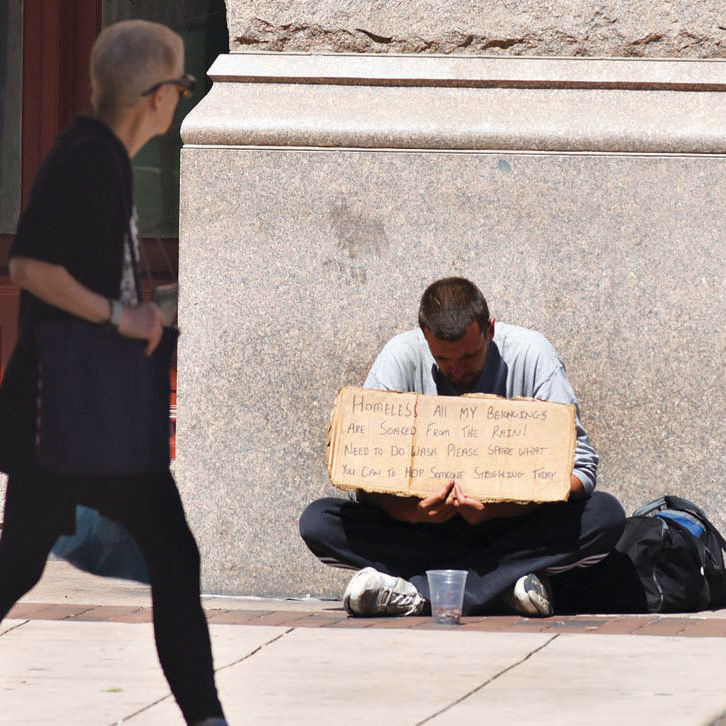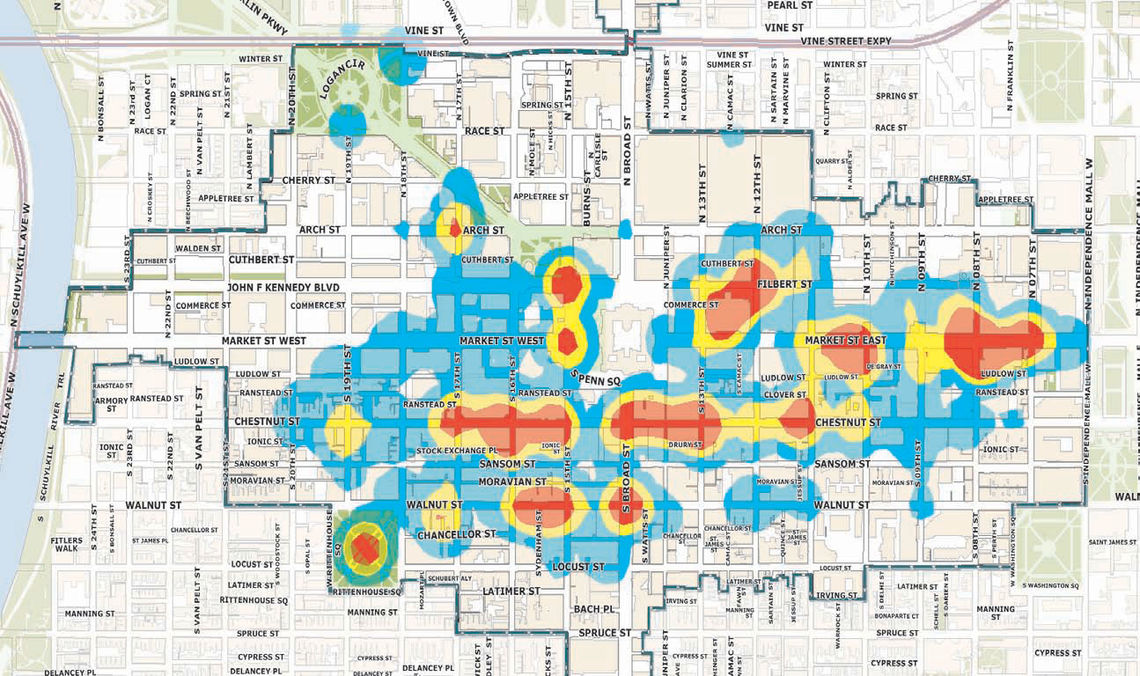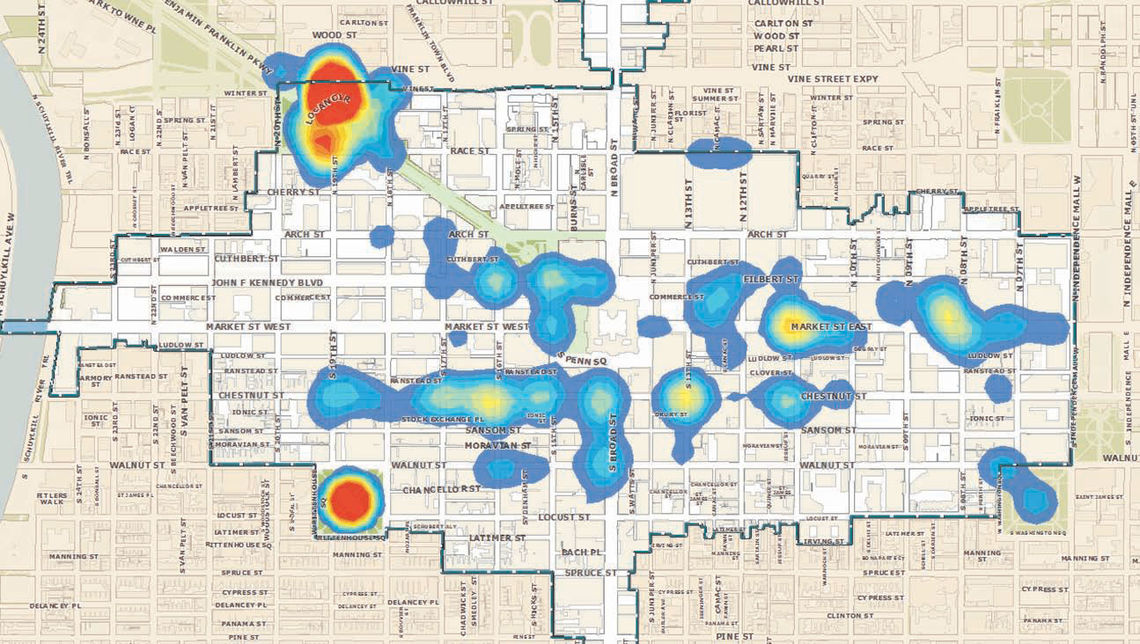
digest
Recommendations on Homelessness
A retailer on Chestnut Street repeatedly encounters someone sleeping in his doorway each morning. Often the individual has defecated on the sidewalk. One morning a mattress completely blocks access.
An office building manager on Market Street finds an individual rolled up in a plastic tarp on their plaza each morning, debris strewn about. Nearby, a religious group preaches hate-speech at lunchtime with amplification loud enough to be heard inside.
Hotels experience behavioral problems with mentally ill individuals within their lobbies, prompting business cancellations. Major conventions receive attendee complaints about aggressive panhandling and unhealthy conditions around the Center.
Near the Schuylkill River, residents walking their dogs step over litter and human waste and occasionally face intimidating behavior from an encampment under the adjacent bridge. Along South Broad Street, panhandlers sit quietly with signs; others ask politely for money. Some block the path of pedestrians who say no.
The incidents above are far from the dominant experience in Center City. But they occur frequently enough to impact perceptions and economic realities. In the last year, CCD surveys counted an average 29 panhandlers each day in the central business district, with a high of 54 in May 2015 and a low of 15 in January 2015.
In the same period, an average of 49 homeless people each day were on sidewalks and in alleys downtown, reaching a high of 132 in August 2014 and a low of 13 in January 2015. City outreach teams count 300 to 400 overnight when adding subway concourses, edges of highways and areas adjacent to downtown (see maps below).
These are but a small percent of the 5,700 people who may be homeless in Philadelphia on any given day. Over a year, 15,000 to 20,000 different individuals may experience episodes of homelessness, the bi-product of evictions, family conflict, abusive situations, mental disorder or drug abuse. Half are families with children, eager for shelter. Almost equal in number are single adults in shelters or living long-term in transitional and permanent housing.
But 6% to 8%, primarily single men, remain on the street even when options are offered. Dedicated outreach workers try. With extraordinary patience, they repeatedly engage chronic individuals, but succeed only 35% of the time. Those remaining are deeply-troubled, suffering from mental illnesses that make them averse to being around other people. Some hear voices and fail to take prescribed medications. To support addiction some commit crimes. Others are victims of crime. Some accost pedestrians; many keep to themselves.
A 1990s study found those who remain on the street have a mortality rate four times higher than non-homeless peers. To respond, the City offers 24-hour, “Safe Haven” facilities for hard-to-reach homeless, unable or unwilling to participate in recovery services.
Between 2008 and 2014, the City’s homeless housing inventory increased from 3,047 to 5,500, while the number of unsheltered persons on the streets decreased from 457 to 361.
Having sufficient resources matters; but spending them wisely is essential.
Time to Rethink What We Do
Anyone who runs a large business or organization knows that programs, products and services build their own internal constituencies. The upside is passionate pride of ownership. The downside can be attachment to the status quo, even when conditions change. Particularly for public agencies, lacking the spur of competitive providers, there are not always
incentives to stay client-focused.
But a change in Mayor creates conditions for rethinking. In 1992, at the start of the Rendell Administration, a grant from The Pew Charitable Trusts enabled Philadelphia to work with a cross section of homeless providers, civic and business organizations to evaluate how $49 million of public dollars were being spent by seven separate, uncoordinated agencies that operated without a strategic plan.
An outside consultant, Fairmount Ventures, catalogued spending across multiple departments for diverse populations: mothers with children, the mentally ill, the addicted, abused women and veterans. They evaluated effectiveness, identified
gaps, recommended efficiencies, better coordination and helped create a seamless continuum of services coordinated by one homeless “czar.”
This enabled the City to leverage more federal and philanthropic resources. Philadelphia now spends $80 million to $100 million each year on homelessness, depending on the success with grants. Charities contribute more. But centralized coordination seems less apparent. Much has also changed in two decades as new innovative approaches have emerged.
Housing First
In 2008, City government invited Pathways to Housing to bring their “housing first” approach to Philadelphia. Pathways focuses exclusively on chronically street homeless people with serious mental illness and behavioral health disorders.
Traditional approaches to the shelter-resistant start with outreach teams offering food, a place to sleep in shared quarters, and access to social and medical services. The cornerstone of “housing first” is the direct placement of the homeless into their own rental apartment without first requiring a period of sobriety or the acceptance of specific services. It seems counter-intuitive, but living with groups of others is often hugely challenging for those with mental illness. Recognizing the debilitating effects of remaining on the street, this approach seeks to reduce harm. Once housed, clients are regularly visited by case managers and offered appropriate supportive services.
Not only is this substantially more effective than traditional approaches to persuading people to come off the street, Pathways to Housing PA currently houses 430 people and maintains an 89% retention rate even among those not considered "housing ready" by other programs (pathwaystohousingpa.org).
Most important, it’s half the cost: $28,500 per person per year for emergency food, housing subsidies, utility bills, mental health and primary care and addiction counseling services, compared to $56,500 per person annually for congregate housing. Housing first also reduces substantial costs this troubled population incurs through recurring encounters with outreach teams, police and emergency rooms. Finally, Pathways leases vacant apartments in the city, avoiding the challenge of placing facilities in wary neighborhoods; tenants pay 30% of their income toward rent.
Center City District Weekly Panhandle Survey: Jan 1 - Sept 1, 2015, Between 12 PM - 1 PM

Center City District Bi-Weekly Homeless Survey: Jan 1 - Sept 1, 2015, Between 10:30 AM - 11:30 AM

CCD surveys counted an average of 49 homeless people each day on sidewalks and in alleys and parks in the District reaching a high of 132 in August 2014 and a low of 13 in January 2015.
A Better Way to Address Hunger
For more than a decade, religious groups have come to the Benjamin Franklin Parkway to provide food and preach to the indigent. Many are well-meaning, but short-sighted. Few provisions are made for clean-up, let alone public bathrooms. Concerned about limited food supply, the hungry congregate early, often camping overnight or pushing to the front of the line. They may receive food, but little to address mental health, medical, addiction, legal or other problems that have led to life on the street.
By contrast, Broad Street Ministries (BSM) provides an indoor setting with nutritious meals and comprehensive services to stabilize men and women experiencing homelessness and poverty (broadstreetministry.org). In partnership with major downtown hotels and
hospitality leaders, BSM offers meals prepared by a professional chef and served tableside without the uncertainty and indignities of waiting in line. BSM’s mission is building trust, while providing access to stabilizing services that lead toward self-sufficiency. Volunteers from partner organizations provide psychiatric and behavioral health services, HIV/AIDS testing, assistance in applying for public benefits, legal services, therapeutic art, clothes mending and something as simple as mail service. Mission-driven
leadership and volunteers from the hospitality industry reinforce a culture of customer service.
Community Court
Another multi-disciplinary approach that succeeded for almost a decade was the Philadelphia Community Court. This
innovative effort placed criminal justice and social service agencies under one roof, fashioning a holistic response to
quality-of-life crimes, including theft from auto, retail theft, minor drug possession, vandalism and prostitution. By focusing on offenses, carefully negotiated by the Public Defender,
District Attorney and Police, the Court addressed both illegal behavior and the underlying causes of that behavior. It provided alternatives to incarceration and covered almost a third of the city: Center City, University City and major portions of North and South Philadelphia.
Individuals, arrested for minor offenses, were provided expedited hearings, no later than the next business day. They were offered evaluations, performed by on-site social service and mental health professionals. They could plead not-guilty and follow the traditional process or accept Court jurisdiction. Most used the moment of crisis precipitated by arrest to deal with issues they had been avoiding.
If they accepted the Court’s jurisdiction and pled guilty, their sentence might include on-site classes in drug treatment readiness and anger management, as well as health screenings, medical care and referrals. They connected to drug treatment, health care, education and job training programs that sought to break the cycle of crime.
They performed well-supervised community service sentences as restitution to the neighborhoods in which they committed their crime. Upon successful completion of the sentence, the arrest was expunged from their record. That was the incentive to participate.
Community service sites included sidewalk cleaning, landscape maintenance and graffiti removal, working with crews of the Center City District and the University City District. Others were placed with community associations to assist with neighborhood clean-ups and in the offices of nonprofit organizations that provided services to the homeless.
Seventy percent of individuals arrested for misdemeanors accepted the Court’s disposition, participated in social service programs and performed their community sentence; 72% were not again arrested for a misdemeanor. By contrast, half of those who did not accept the Court’s disposition were arrested on similar charges shortly thereafter.
The Court was a victim of budget cutting during the Recession and ceased to operate after 2012. Petty crimes again get lower priority. Troubled individuals commit offenses not warranting jail time and cycle back to the street. Officers grow reluctant to take action on low-level offenses. Some disruptive, illegal acts are effectively decriminalized.
Changed Legal Landscape
From 1997 to 2000, programs for the homeless expanded and City-funded outreach teams partnered with specially-trained police. The Commonwealth statute prohibiting obstructing the highway provided leverage to urge homeless to accept transport to shelter. Very few arrests were made, but on-street numbers dropped to their lowest in 25 years. Then attorneys representing several homeless individuals brought suit against the City, alleging a violation of their clients’ rights.
The City agreed to end sidewalk enforcement of obstructing the highway. In early 1999, then-Council President John Street secured passage of the Sidewalk Behavior bill. Police who encounter illegal activity now must give oral and written notice to those they believe to be homeless. They must contact civilian outreach teams, who must concur before officers can do more. If no outreach is available, police can’t act. If outreach comes and individuals refuse services, police can only write a civil citation. If offensive conduct stops when outreach workers arrive, but resumes when they leave, police can do little. In 2001, police were also directed not to enforce Fairmount Park’s overnight curfew.
An exception to these procedures occurs during extreme weather when, for life-safety reasons, advocates have concurred that police working with outreach teams can bring those with impaired judgment inside if they won’t come on their own. Arrests are not made, but public authority is used to move people from danger to safety.
Since 2001, the legal context has substantially changed. As William Martin, Esq., outlines on page 6, courts in many states have rejected municipal ordinances that prohibit sleeping or lying in public spaces, based upon the protection against “cruel and unusual punishment” provided by the Eighth Amendment. Regulating panhandling has become harder too in most cities. But, as Martin notes, carefully crafted municipal programs that balance quality services and enforcement have been upheld.
Next Steps
The next Mayor should not lead with enforcement, but rather use the transition to evaluate what works well, what can be improved or better coordinated, what is cost-effective or falling short of goals. Restoring job-readiness programs of the 1990s that provided transitional, subsidized work should be part of the solution, especially if trainees are mainstreamed into positions with Philadelphia’s larger improvement districts and the maintenance programs on college and university campuses.
The examples above are all multidisciplinary approaches, fashioned often by former adversaries cooperating on pragmatic solutions. If war is too important to be left to generals, law enforcement is too important to be left to police, and homelessness is too important to be left to social workers. Extraordinarily challenging, this problem is solved best not with placards and slogans, nor simply by money, but through the thoughtful integration of multiple disciplines. There can be no sacred cows. Too many lives are at stake, as is the vitality of the city.
Paul R. Levy
President
plevy@centercityphila.org